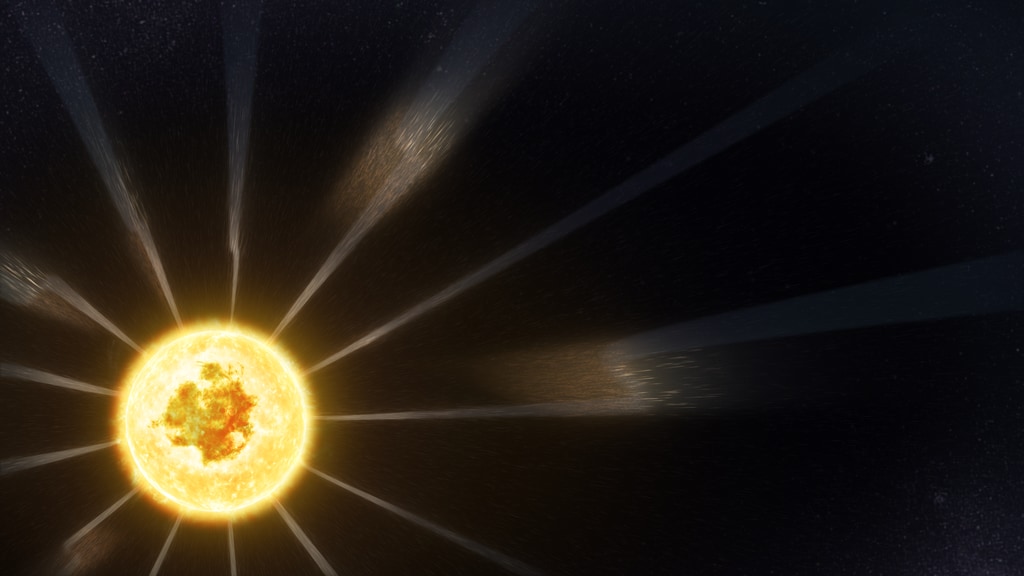5 New Discoveries from NASA's Parker Solar Probe
Music Credit: Smooth as Glass by The Freeharmonic Orchestra
Watch this video on the NASA Goddard YouTube channel.
Complete transcript available.
NASA's Parker Solar Probe mission has returned unprecedented data from near the Sun, culminating in new discoveries published on Dec. 4, 2019, in the journal Nature. Among the findings are new understandings of how the Sun's constant outflow of material, the solar wind, behaves. Seen near Earth — where it can interact with our planet's natural magnetic field and cause space weather effects that interfere with technology — the solar wind appears to be a relatively uniform flow of plasma. But Parker Solar Probe's observations reveal a complicated, active system not seen from Earth.
Artist interpretation of a dust-free zone around the Sun. Credit: NASA Goddard/Scott Wiessinger
Artist rendition of a small scale particle event on the Sun. Credit: NASA Goddard/Adriana Manrique Gutierrez and Scott Wiessinger
Artist rendition of a small particle event becoming too spread out to be detected from Earth. Credit: NASA Goddard/Scott Wiessinger
Credits
Please give credit for this item to:
NASA's Goddard Space Flight Center
-
Writers
- Karen Fox (ADNET Systems, Inc.)
- Sarah Frazier (ADNET Systems, Inc.)
-
Producer
- Genna Duberstein (USRA)
-
Editor
- Genna Duberstein (USRA)
-
Narrator
- Chris Smith (USRA)
-
Animators
- Adriana Manrique Gutierrez (USRA)
- Jonathan North (USRA)
- Scott Wiessinger (USRA)
-
Scientists
- Adam Szabo (NASA/GSFC)
- Russ Howard (NRL)
- Dave McComas (SwRI)
- Stuart Bale (University of California, Berkeley)
- Justin Kasper (University of Michigan)
- Nour Raouafi (Johns Hopkins University/APL)
- Eric Christian (NASA/HQ)
-
Project support
- Adam Szabo (NASA/GSFC)
Release date
This page was originally published on Wednesday, December 4, 2019.
This page was last updated on Wednesday, May 3, 2023 at 1:45 PM EDT.
![Can You Solve NASA’s #3point8 Puzzles?Music Credit: “Laser Cycle Launch Party” by Aaron Michael Wittrock [ASCAP], Julian Daniel Anderson [BMI], & Forrest Reed [ASCAP] via Universal Production MusicProducer: Beth Anthony (eMITS)Writer: Miles Hatfield (eMITS)](/vis/a010000/a014700/a014736/14736_3point8Promo_thumb.png)



![Discovering the Sun’s Mysteriously Hot Atmosphere Something mysterious is going on at the Sun. In defiance of all logic, its atmosphere gets much, much hotter the farther it stretches from the Sun’s blazing surface.Temperatures in the corona — the Sun’s outer atmosphere — spike to 3 million degrees Fahrenheit, while just 1,000 miles below, the underlying surface simmers at a balmy 10,000 F. How the Sun manages this feat is a mystery that dates back nearly 150 years, and remains one of the greatest unanswered questions in astrophysics. Scientists call it the coronal heating problem.Watch the video to learn how astronomers first discovered evidence for this mystery during an eclipse in the 1800s, and what scientists today think could explain it.Music credits: 'Developing Over Time' by Ben Niblett [PRS], Jon Cotton [PRS], 'Eternal Circle' by Laurent Dury [SACEM], ‘Starlight Andromeda' by Ben Niblett [PRS], Jon Cotton [PRS]Coronal spectrum image credit: Constantine EmmanouilidiComplete transcript available.Watch this video on the NASA Goddard YouTube channel.](/vis/a010000/a012900/a012903/CHP_Discovery_1080_4.00001_print.jpg)
![Music credit: Cheeky Chappy [Main Track] by Jimmy Kaleth, Ross Andrew McLean from www.killertracks.com This music requires a license for use.Watch this video on the NASA Goddard YouTube channel.Complete transcript available.](/vis/a010000/a012800/a012867/meltthumb.jpg)
